Masters of Modern Soccer: Chicharito and the Art of Mexico's Synchronization
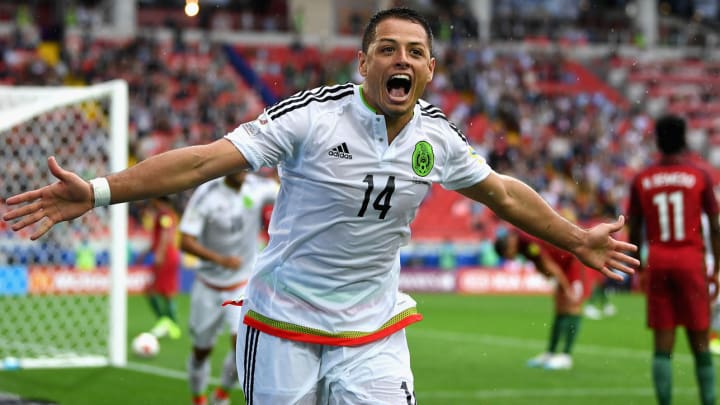
The following is excerpted from Masters of Modern Soccer: How the World’s Best Play the Twenty-First-Century Game. Copyright © 2018 by Grant Wahl. Published by Crown Archetype, an imprint of Penguin Random House LLC.
The most popular soccer team in the United States is the Mexican men’s national team. El Tricolor, or El Tri, as it’s known, regularly fills NFL stadiums, even for meaningless friendlies. TV ratings for Mexican soccer on U.S. Spanish-language channels are huge. The Mexican league, Liga MX, draws bigger audiences on U.S. television than any other soccer league in any language—more than the English Premier League, more than the UEFA Champions League, and certainly more than Major League Soccer. When Telemundo won the U.S. Spanish-language World Cup television rights for the eight-year period from 2015 to 2022, it paid FIFA $600 million, a full $175 million more than Fox Sports paid for the U.S. English-language TV rights. Thanks to El Tri, no country in the world pays FIFA more money for World Cup TV rights than the United States.
Mexican fútbol is big business in the States, owing to decades-long immigration patterns and the tendency of Mexican-Americans to identify with Mexican soccer as part of their cultural heritage. In fact, Mexico plays more games in the United States than it does in Mexico, not least because its fans in the States have more disposable income than those south of the border.
And so I find myself in a Denver hotel for a rare hour-long audience with two men: Mexican forward Javier “Chicharito” Hernández, his national team’s all-time leading goal scorer, and El Tri’s manager, the Colombian Juan Carlos Osorio. Why Denver? Well, Osorio has decided to bring Mexico here for altitude training between friendlies in the Los Angeles and New York City areas. And why is this joint interview rare? For starters, national teams don’t get together very often; the club game takes up most of the annual calendar. Beyond that, Hernández and Osorio are almost never available for interviews at the same time, and neither one particularly wants to spend time with most of the Mexican soccer media. “They talk about other things,” says Osorio, “like Javier’s romantic life, blah, blah, blah, blah, blah.”
“Everything but football,” Hernández says with a laugh, shaking his head.
With his round face, deep-set eyes, and a Roman haircut that he sometimes leavens with gel, Chicharito (“Little Pea” in Spanish) is the personification of the term Mexican matinee idol. It would not be folly to presume that as a goal scorer who has played in the satellite television era for Manchester United and Real Madrid—the two most popular soccer clubs on the planet—Chicharito is known by more people on Earth than any Mexican in recorded history.
Osorio has one thing he wants to talk about today. “This is football,” the manager says, pointing with both hands to the elaborate setup he has constructed between us. “This is the game.” We’re seated just outside Mexico’s hotel dining room around a knee-high wooden table, on which Osorio has laid out 22 circular tabs—11 green, 11 red—that he carries in a Ziploc bag wherever he goes. Downstairs, fans in green Mexico jerseys are gathered outside the hotel entrance, waiting for the chance to nab autographs from their heroes. In the lobby, a few media members wait for a short group press event taking place later. But upstairs, away from the television cameras, class is in session with Profe Osorio. (In Latin countries, coaches are often called Profe, short for Professor.)
“This is my own crazy idea of preparing my team to play in the last 25 meters,” says Osorio, who has been a coach on club teams in Colombia, Mexico, Brazil, England, and the United States. “We need constant movement from our strikers. We try to create patterns. We’re taking movement to a new level, and we call it synchronization. The key words are doubt, movement, and synchronization.”
“Synchronization!” says Hernández, chewing over the English word with satisfaction. “Exactly.”
“In the national team, we play with a front three and only one main striker,” Chicharito says. “The movements are different” than in the two-forward formations he has often been deployed in at club level with Manchester United, Germany’s Bayer Leverkusen, and, more recently, West Ham United.
BUY NOW

Masters of Modern Soccer
by Grant Wahl
How do some of the game's smartest figures master the craft of soccer? By profiling players in every key position and management, Wahl reveals how elite players and coaches strategize on and off the field and execute in high pressure game situations.
Chicharito’s efficiency and consistency at club level have carried over to his national team. In May 2017, at just 28 years old, he scored his 47th international goal to break Mexico’s all-time record, held by Jared Borgetti. A few days later, Hernández sits next to me in Denver with Osorio, who hopes to unleash Hernández even more as a goal-scoring force with his new system of player patterns and synchronization in the Mexican attack. Osorio wants one thing to be clear, however: He and Chicharito are going to show me Mexico’s secrets, but they can’t come out publicly until this book is released in May 2018.
“Are you sure?” Osorio asks. “May, yes. Not now. You promise?”
“I promise.”
“So you will not talk to anybody about this?”
“I will not only not print it now for Sports Illustrated. I won’t even speak about it to anyone privately.”
“OK,” Osorio says. “So we will show you today.”
Chicharito smiles and rubs his hands together. He loves this stuff.
One of the biggest misconceptions about soccer is that, unlike other sports, such as American football or basketball, there are no designed plays during the run of play. I can’t tell you how many times over the years I have been lectured—usually by a so-called soccer “mastermind” from Europe—that Americans struggle at the world’s most popular sport because we’re conditioned by our culture “to do what you’re told by the coach,” military-style, on designed plays in American football and basketball, instead of showing the self-taught creativity that’s found in soccer.
This is nonsense on multiple levels. For one thing, the most popular U.S. pro team sports feature plenty of creativity, especially basketball, in which players are given the freedom to improvise within the framework of a designed play and often ignore the coach’s instructions altogether. What’s more, the idea that soccer has no designed plays simply isn’t true. Obviously, there are choreographed sequences on dead-ball situations—set plays—which are drawing more attention than ever from soccer’s data analysts as a way to maximize goal-scoring chances from free kicks near the box. (Atlético Madrid has made a science of scoring on set plays under manager Diego Simeone, while the 2015–16 Danish league champion, Midtjylland, even hired a former NFL player to come work with the team on creative set pieces.)
Masters of Modern Soccer: Christian Pulisic and the Craft of the Attacking Midfielder
But even during the run of play, many of the world’s top soccer teams design and execute systematized patterns that have a framework not unlike what we see in an NBA half-court offense. These patterns appear most often in club soccer, in which the players are together year-round and have the time to work on perfecting their timing and understanding of each other’s tendencies. But some national teams run patterns as well, including Mexico under Juan Carlos Osorio. “I love basketball,” Osorio tells me. “I can see so many movements, and they specifically have many patterns where if they want the ball to be with the point guard or a playmaker, they will synchronize the movements and the right player will end up with the ball.”
And so Osorio has designed patterns with the objective of increasing the chances that Chicharito receives a ball in the box with the opportunity to score a goal. How does Osorio do this? For starters, the Colombian manager is fascinated by the scientific study of the human brain and its applications to his players. During my two days with the Mexican team, Osorio instructs one of his assistants, Jorge Enrique Ríos Duque, to show me The Brain, a program produced by the History Channel that details how the brain functions in elite team sports and in other human contexts. The program, which Osorio has shown to all his Mexican players, includes scenes of Cirque du Soleil members in a discussion of kinetic intelligence; of the former major league baseball player Shelley Duncan saying 90 percent of elite sports is mental; and of a former concert pianist with Alzheimer’s disease who’s still able to play complex tunes because they are part of his brain’s procedural memory.
“My father was diagnosed with Alzheimer’s,” Osorio says. “I go and play billiards with him. He’s 86, so now he doesn’t have the ability or accuracy, but when he sees something, I tell him, ‘What are you going to do?’ He says, ‘I’m going to hit this ball into this side, and it’s going to take this turn or movement.’ He knows. That’s procedural memory. How we shave in the morning. How we walk. How we ride a bicycle. How you drive. How you play a football match.”
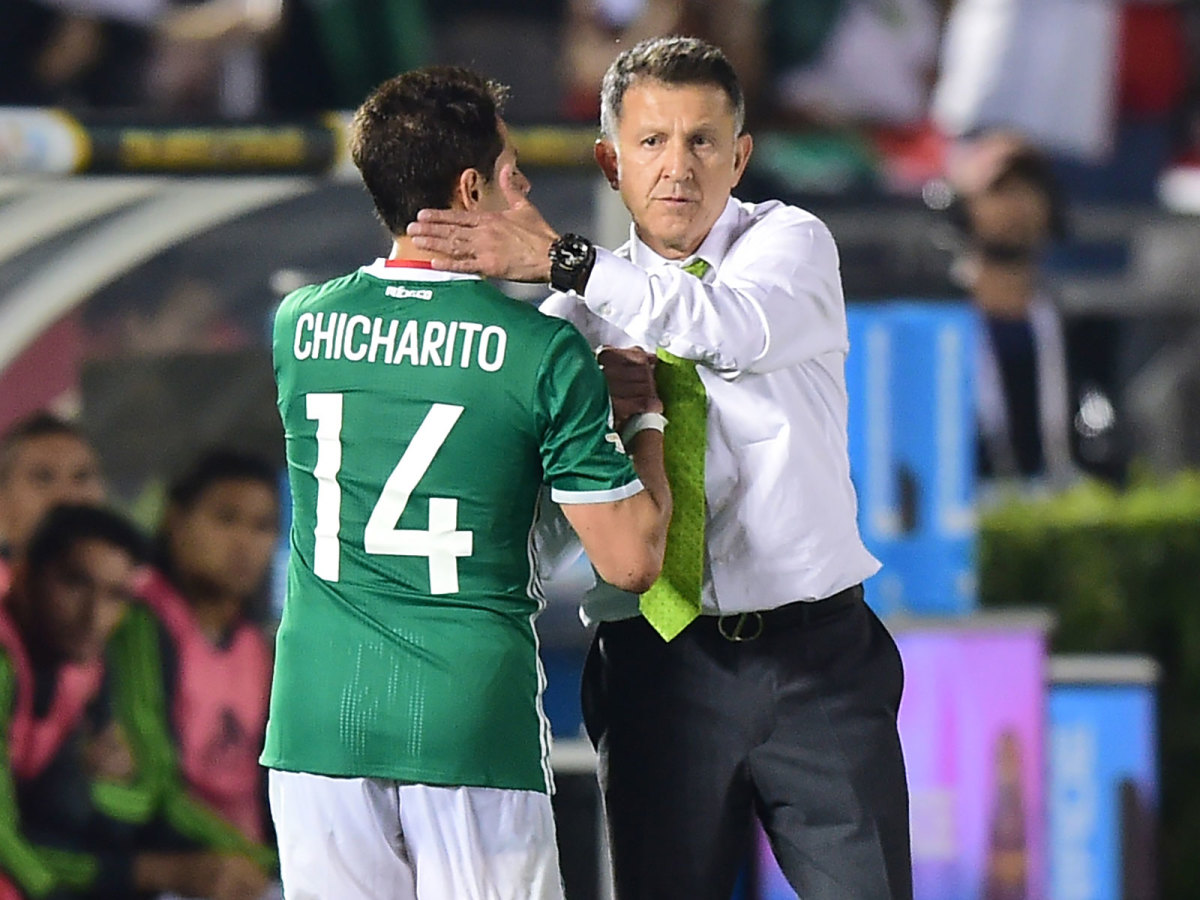
Osorio says he uses every training session to model game situations with the patterns he has developed for the team, so that they become second nature to his players. If they go through the same framework 10 to 15 times in every practice, Osorio argues, they will do it right sometimes and wrong at other times. But that repetition will eventually cause them to store the information in their brains’ procedural memory. “The training has to be real-game situations,” he says. “It has to be specific, and it has to be down to the smallest details. You have to synchronize all those movements. We try to create patterns. We love to play offensive football, enjoyable football, so we want to bring the ball from the back. And we need patterns. Patterns to bring it from the defensive third into the middle third. Now we improve that and try to have patterns to bring it from the middle third into the offensive third.”
Part of Osorio’s instructions for his Mexican attackers involves putting themselves in specific zones on the field. “We use the natural lines on the field,” he says, “to try and create an understanding of where everybody has to run, including the striker, when the ball is in certain positions.”
Take crosses, for example. Based on research of the English Premier League, Osorio says, more than 50 percent of the crosses that result in a goal come from a 10-by-14-meter zone coming out from either far corner of the penalty box. That’s where he wants his team’s crosses to originate. As for the striker on the end of those crosses, Osorio wants him to be stationed in what he calls the “second 6-yard box”—a zone that can be imagined if you take the existing 6-yard box and move it out 6 more yards from the goal, so that line includes the penalty spot (which is 12 yards from the goal line). He can run to either the near post or the far post, but if the striker is in the second 6-yard box, Osorio reasons, the cross is more likely to reach him without being picked off by the goalkeeper coming off his line.
“We try to get our attackers to go to specific areas to play our percentages, as opposed to just leaving it to the creativity of the players,” Osorio explains. “We do have very creative players, and we encourage them to play to their abilities, but we also understand it’s very important that we have certain patterns to at least have good points of reference for all the strikers to move to.”
Osorio has several solid strikers at his disposal, including Carlos Vela, Giovani Dos Santos, Raúl Jiménez, Marco Fabián, and Oribe Peralta. But his first choice for the lone centerforward position in his 4-3-3 formation is Chicharito. That doesn’t mean Hernández starts every game—Osorio is famous for his rotation policy, in which he makes anywhere from two to eight changes in the lineup for each game—but if Mexico is in a must-win situation, you can be safe assuming Chicharito will be on the field. “If I compare Javier with other great goal scorers, there are certain things that are common to all of them,” Osorio says. “One, he has a knack for the goal. Sometimes it seems like every rebound or every deflection goes into his path. Another thing is he doesn’t dwell on a missed opportunity. He always looks forward to the next one. He has good ability in the air. He has good pace, and he makes those diagonal runs starting from the first defender in behind the second one. He also has the willingness to work defensively.”
How do Osorio’s designed attacking patterns work with Chicharito and the rest of his Mexican teammates? In Denver, the two men sit down together with me and explain the details of two different examples of El Tri’s synchronization.
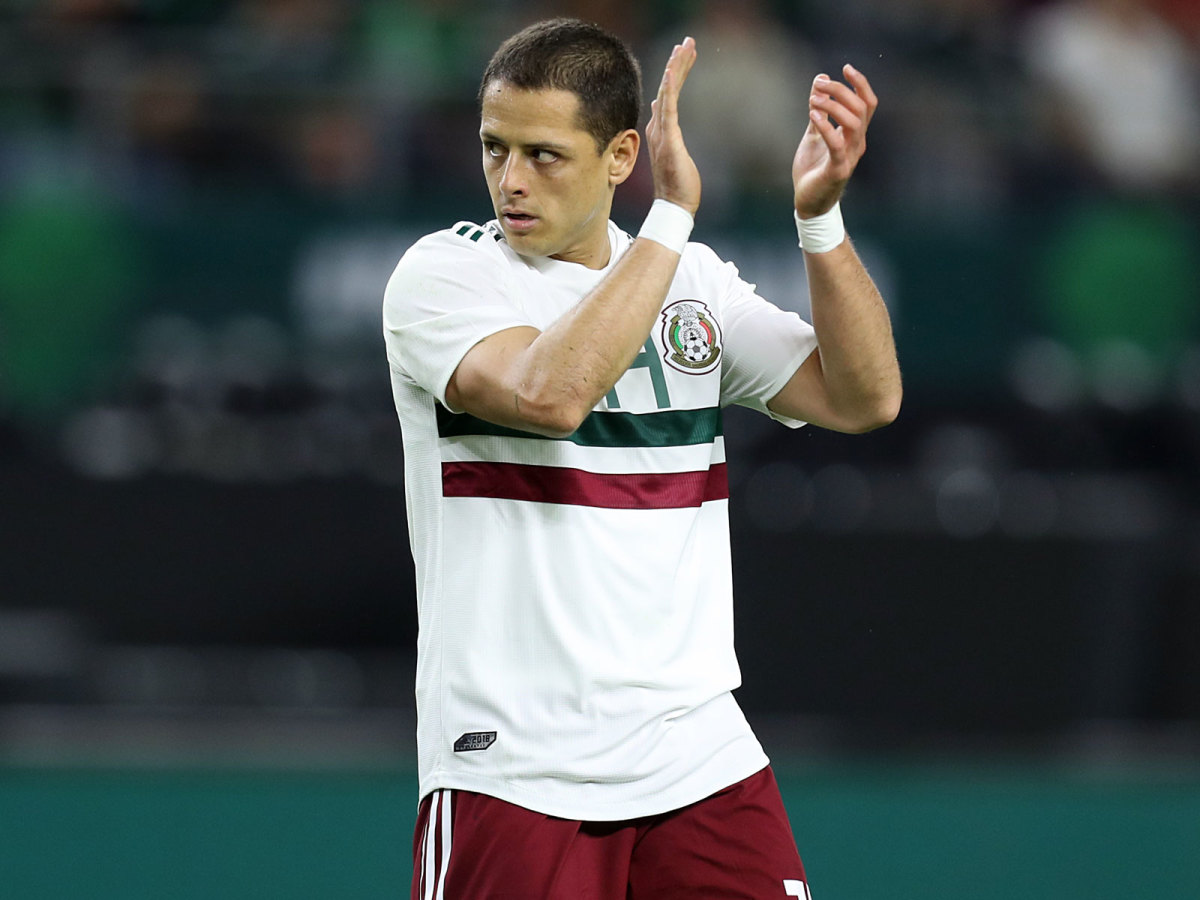
SYNCHRONIZATION NUMBER 1
USING CHICHARITO AS A SURPRISE LEFT-WINGER
In Mexico’s World Cup qualifier at home against Costa Rica on March 24, 2017, Osorio pulled a huge surprise on the Ticos, moving Hernández away from his customary centerforward position and starting him instead on the left wing of Mexico’s front three. Target man Oribe Peralta got the call in the centerforward spot. Osorio trained his players in the new setup every day in the week leading up to the game, and Chicharito was encouraged by how many scoring chances they created for him in practice. But he had no idea the plan would work so well in the game, with the designed pattern setting up his eighth-minute goal, just as they had drawn it up on the tactical board. Hernández’s finish, in which he one-timed Vela’s pinpoint pass just a moment before being cleaned out by onrushing Costa Rican goalkeeper Keylor Navas, was a thing of beauty. But there was a richly choreographed process that led up to it.
Sitting above the table where the manager has laid out 11 green circular tabs (for Mexico) and 11 red tabs (for Costa Rica) in their teams’ respective formations—4-3-3 for Mexico, 5-4-1 for Costa Rica—Osorio and Chicharito take turns moving the puzzle pieces and explaining how their team’s synchronization patterns worked that night on the first goal of Mexico’s 2–0 victory.
The keys to the goal lay in several elements: surprise, numerical advantage, the synchronization of the Mexican attackers, and the creation of doubts in opposing defenders. The surprise comes from deploying Chicharito on the left wing and a centerforward of a completely different profile—Peralta, a target man. As Osorio notes, “These three guys [the Costa Rican centerbacks] were waiting for Javier to be here [in the box as a centerforward]. Once they saw him here [on the left wing] they are thinking, Who’s going to take him?” Osorio compounds Costa Rica’s problems by creating a tactical numerical advantage in the central midfield, where Mexico has three players to the Ticos’ two. In cases of numerical advantage, obviously, one attacker is always going to be open and defenders will be forced to engage with one or hedge and be caught in the middle, neither of which is an optimal defensive situation.
Osorio designs a synchronized movement by his players to maximize the leverage of these advantages. When Mexico advances toward midfield with the ball, Peralta retreats from his advanced centerforward position toward midfield, dragging his defender with him and creating open space for Chicharito to run into from the left wing. Due to Mexico’s numerical advantage, Costa Rican right centerback Johnny Acosta will be forced to decide whether to mark Chicharito or midfielder Jonathan Dos Santos. “We wanted to create doubts—with me especially,” Hernández says, “because that was the idea of the movement. [Acosta] has a doubt with Jonathan. And that’s what happened. It was the thing that we practiced in training.”
“Javier wisely used the proper word—doubts,” Osorio says. “That’s what we try to create.” The presence of Dos Santos draws Acosta, who thinks he can intercept a potential pass to Dos Santos, but that leaves Chicharito open. “So the ball goes over to Javier,” Osorio says. “We call this synchronization. Because when [Jonathan] comes forward, Javier has to run, and how do we know that? When we get [centerback Héctor Moreno] on the ball and he moves the ball forward. He’s looking for a pass.”
Hernández flashes a grin. “Synchronization!”
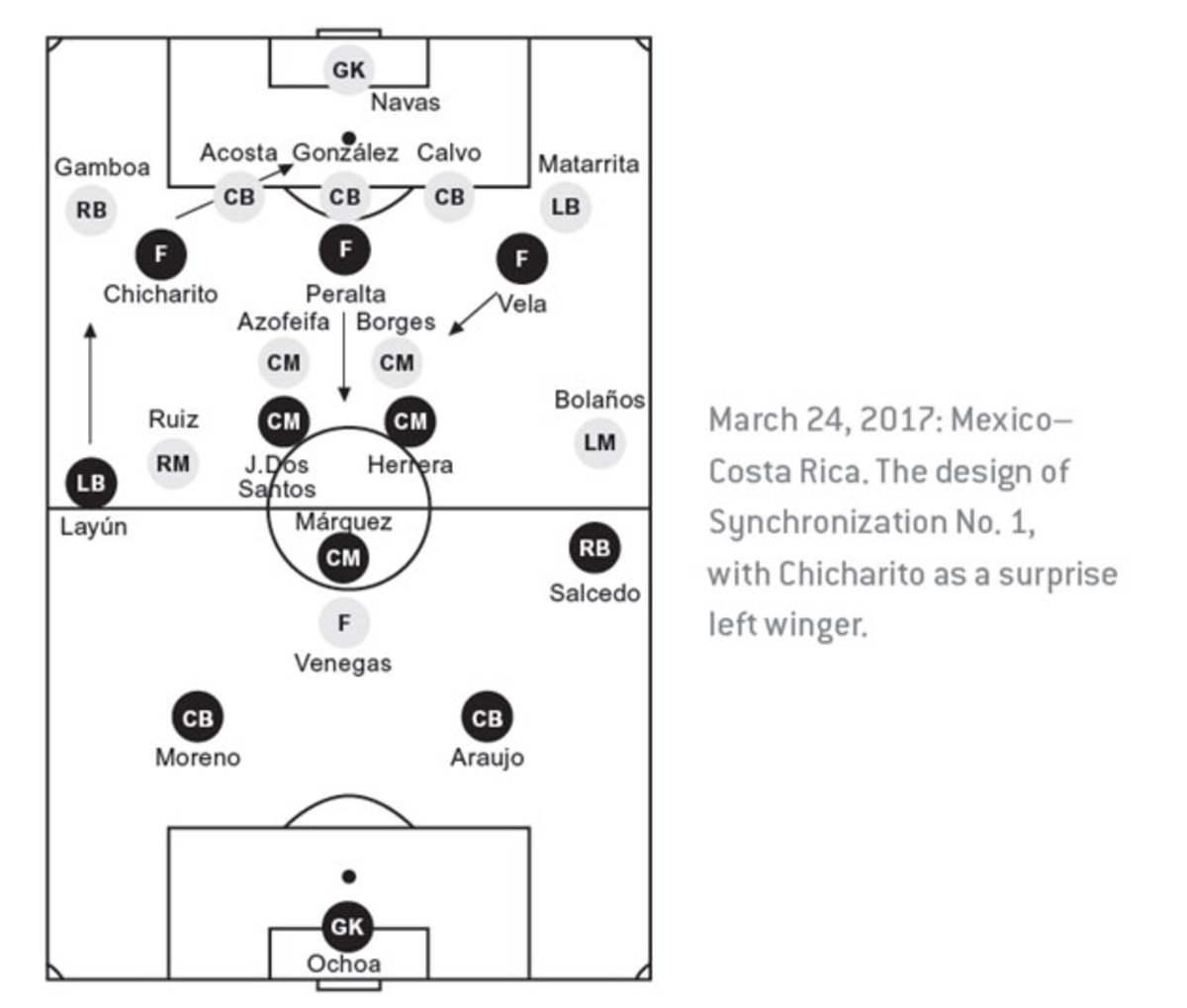
Watching the passing sequence that leads to Chicharito’s goal on video, you marvel at the fluid movements within the structure that Osorio has laid out. Deep in Mexico’s defensive half, Moreno starts everything with a diagonal pass forward to the right centerback Néstor Araujo, who approaches the edge of the center circle unmarked. Costa Rica, packing things in at Estadio Azteca, is applying no defensive pressure in that part of the field. Araujo could pass the ball centrally to defensive midfielder Rafa Márquez, but Costa Rican forward Johan Venegas has dropped back to cover Márquez, who’s looking at Araujo and pointing at the open passing lane farther up the middle of the field.
Araujo sees it. Per Osorio’s instructions, the centerforward, Peralta, has dropped deep as a target man, dragging the middle centerback (Giancarlo González) with him and leaving all sorts of open space upfield in the middle of the penalty box. That’s critical in the design of the play. Araujo rifles a right-footed pass 25 yards on the ground to Peralta, bypassing Mexico’s three central midfielders and breaking Costa Rica’s defensive lines.
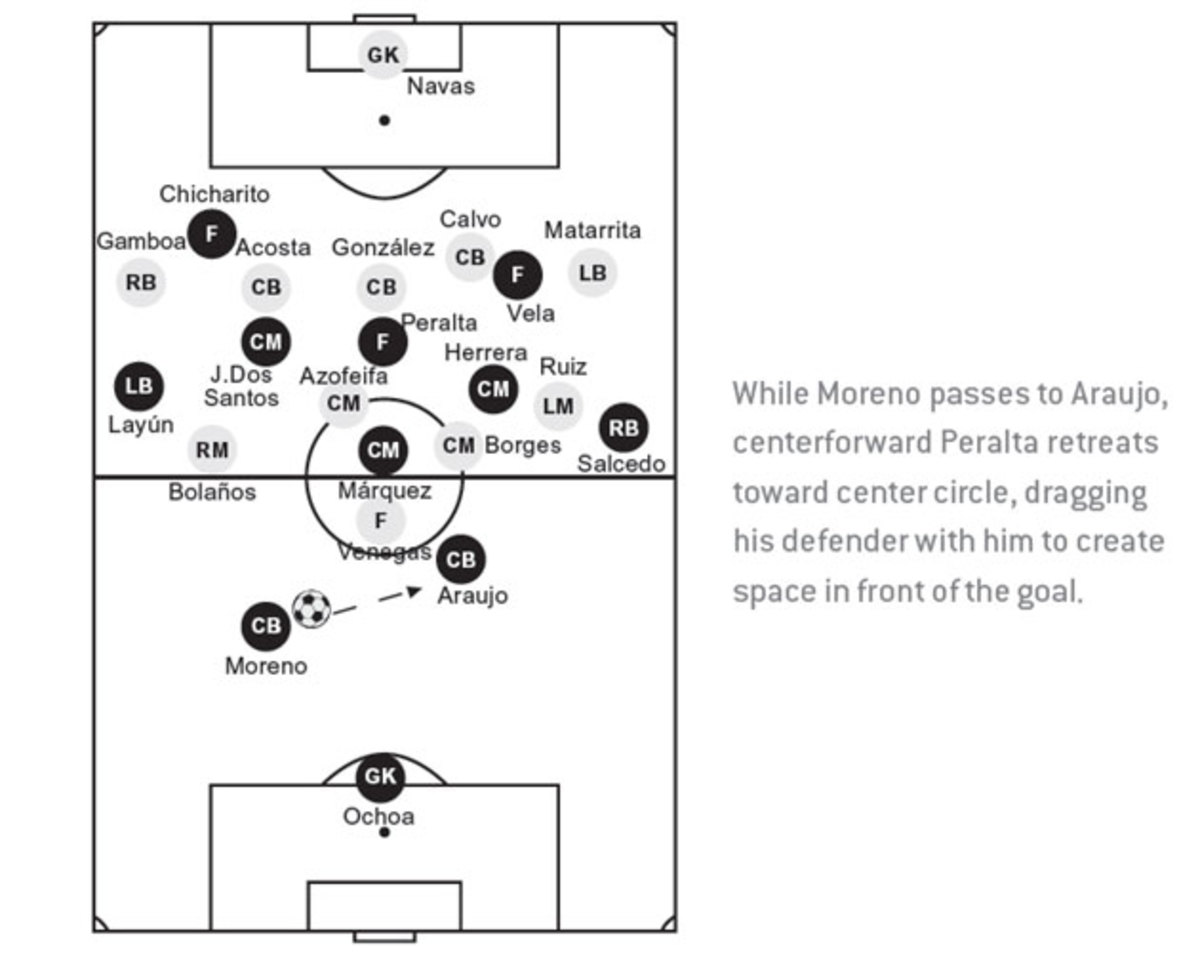
González is in tight on Peralta, whose back is to the goal 45 yards away. Peralta’s first touch on the hot pass isn’t perfect—he pops it up a couple feet above his head—but Peralta uses his body to keep González at bay, then turns to his left (Mexico’s right attacking side) and hits a pass to right-winger Vela running 5 yards ahead in the channel between Francisco Calvo (the left centerback) and Ronald Matarrita (the left wingback).
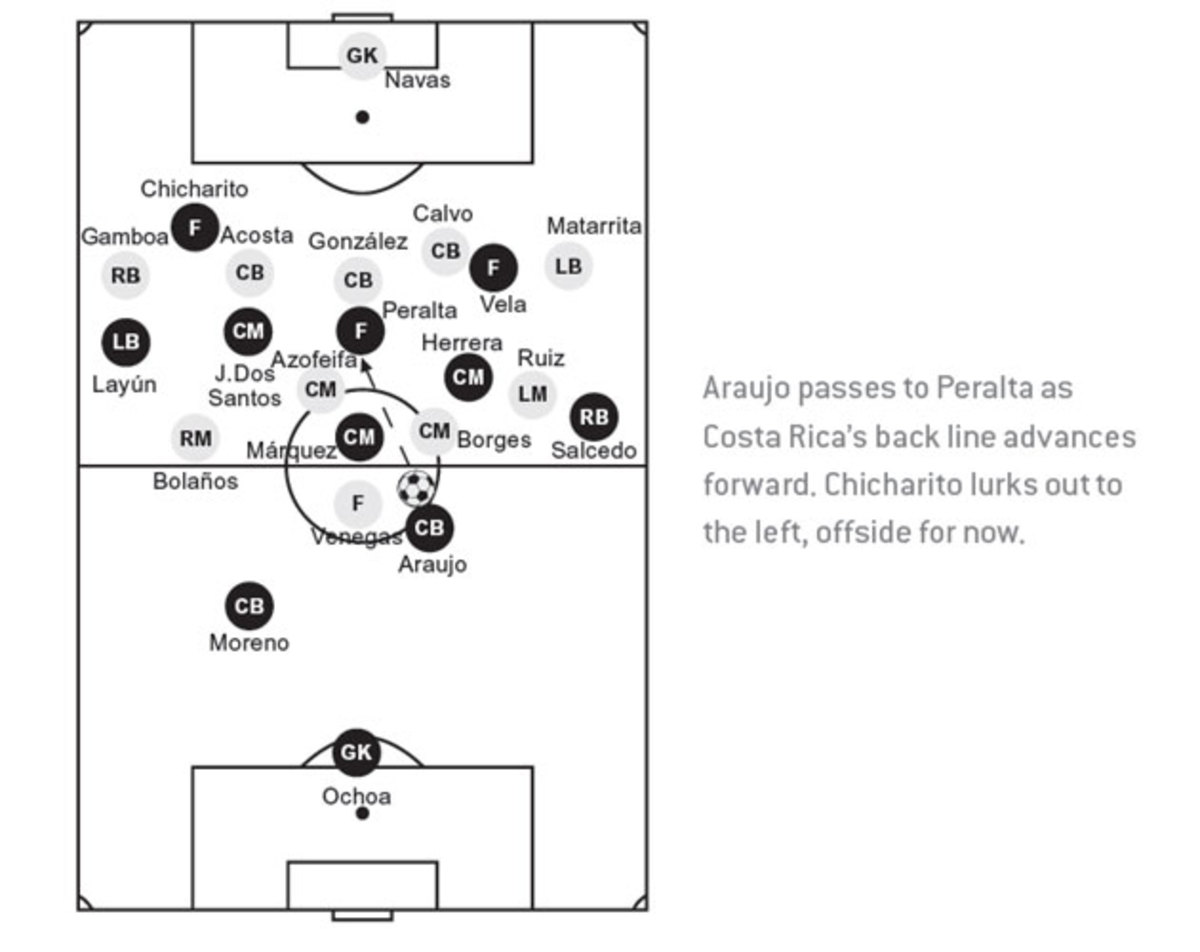
At this point, Chicharito is simply watching the play unfold, standing on the left side in a position that’s 2 yards offside. Costa Rica’s right wingback Cristian Gamboa is a couple yards away, while Tico right centerback Johnny Acosta is in no-man’s-land, marking neither Chicharito (open 5 yards away and behind him) nor midfielder Jonathan Dos Santos (open 10 yards away in front of him). This is the exact doubt that Osorio wanted to create in Acosta: Which player do I mark? Six minutes into the game, Mexico has already surprised Costa Rica by putting Chicharito on the left side and a retreating target man as the centerforward, and now El Tri is compounding the uncertainty for Acosta. The advantage that Mexico has created is even more impressive considering Costa Rica—a World Cup 2014 quarterfinalist that advanced from a group that included Italy, England, and Uruguay—is parking the bus and deploying its tried-and-true, deeply conservative five-man back line.
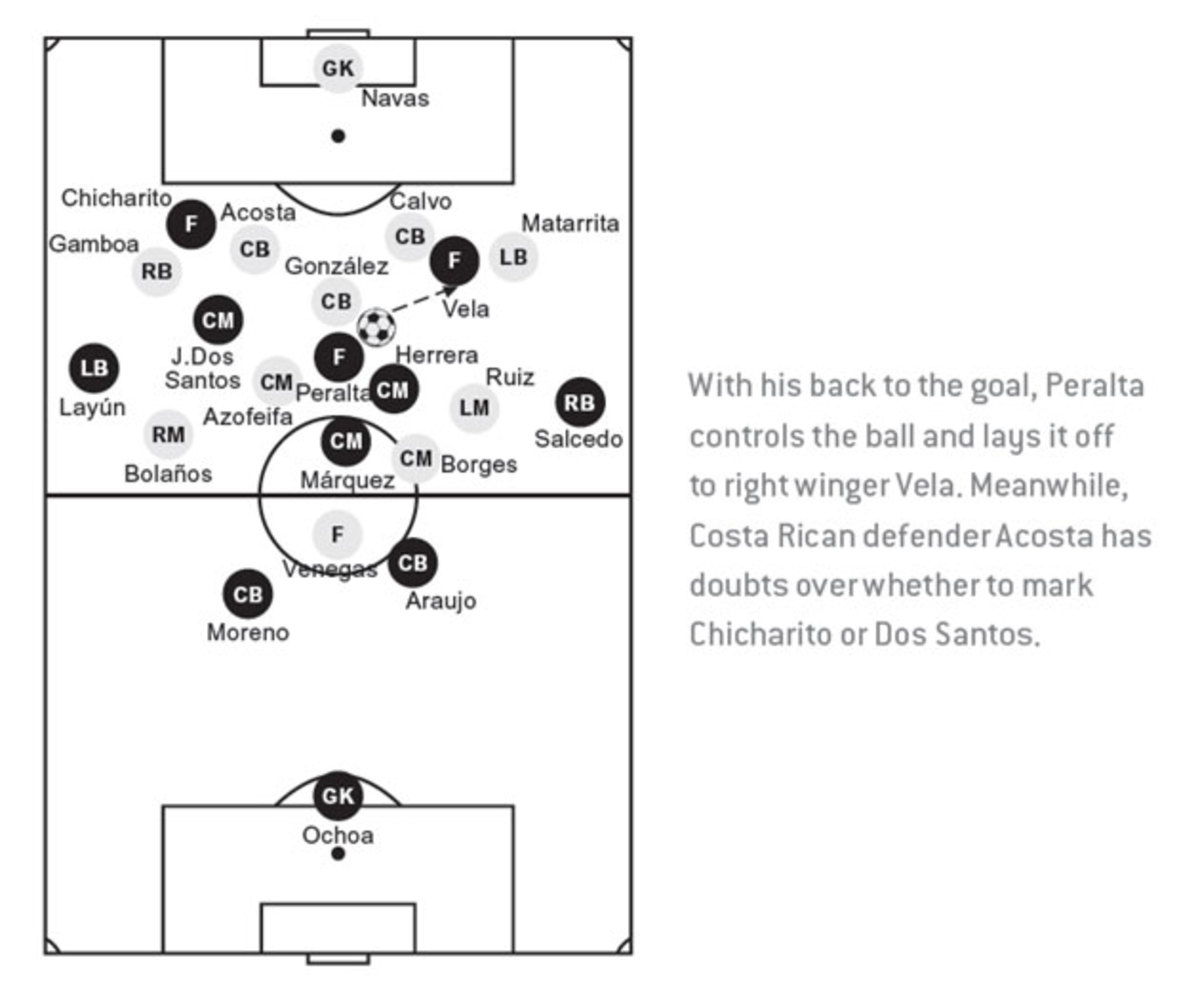
Let’s shift our focus back to Vela and the ball. Osorio likes to use Vela as an inverted winger, a player whose dominant foot is the opposite of the side he’s playing on. As a left-footed attacker on the right wing, Vela rarely stays wide and hits crosses with his weaker right foot, but he often cuts inside to create danger centrally. When he receives the pass from Peralta, Vela has options. If he were a right-footed player, he’d probably try to blast through the channel between Calvo and Matarrita and shoot on goal. Instead, Vela takes his first touch with his trusty left foot and stops on a dime. The move creates a pocket of space between Vela and his two defenders, who have retreated at speed on the right—conveniently rendering Chicharito onside on the left 20 yards away.
Hernández has just started his run, and there is nothing but wide-open green grass between him and the goalkeeper, Navas, 28 yards away. Because Peralta retreated from the centerforward position, the middle centerback, González—who’s supposed to be the rock of the Costa Rican back line—is 7 yards behind Vela and desperately trying to close ground on him. If anyone is going to stop Vela’s pass, it will be González. But Vela is too quick in thought and action, and he jabs a left-footed pass on the ground into the penalty box, right in the path of Chicharito’s run. The only question now is whether goalkeeper Navas, who has taken off from his 6-yard box the moment after Vela released the pass, will get to the ball before Hernández does.
Navas fails. Chicharito meets the ball 13 yards out and chips a right-footed shot over Navas, who’s sliding into the Mexican like a baseball player trying to break up a double play. By the time the ball hits the back of the net, Hernández’s momentum has carried him 8 more yards ahead and he’s flat on his stomach inside the 6-yard box. The look on Chicharito’s face as he celebrates with his teammates—and as the old ThunderDome stadium erupts with noise—is priceless. It’s as though he’s screaming: Can you believe it worked just like we drew it up? Can you really believe it?
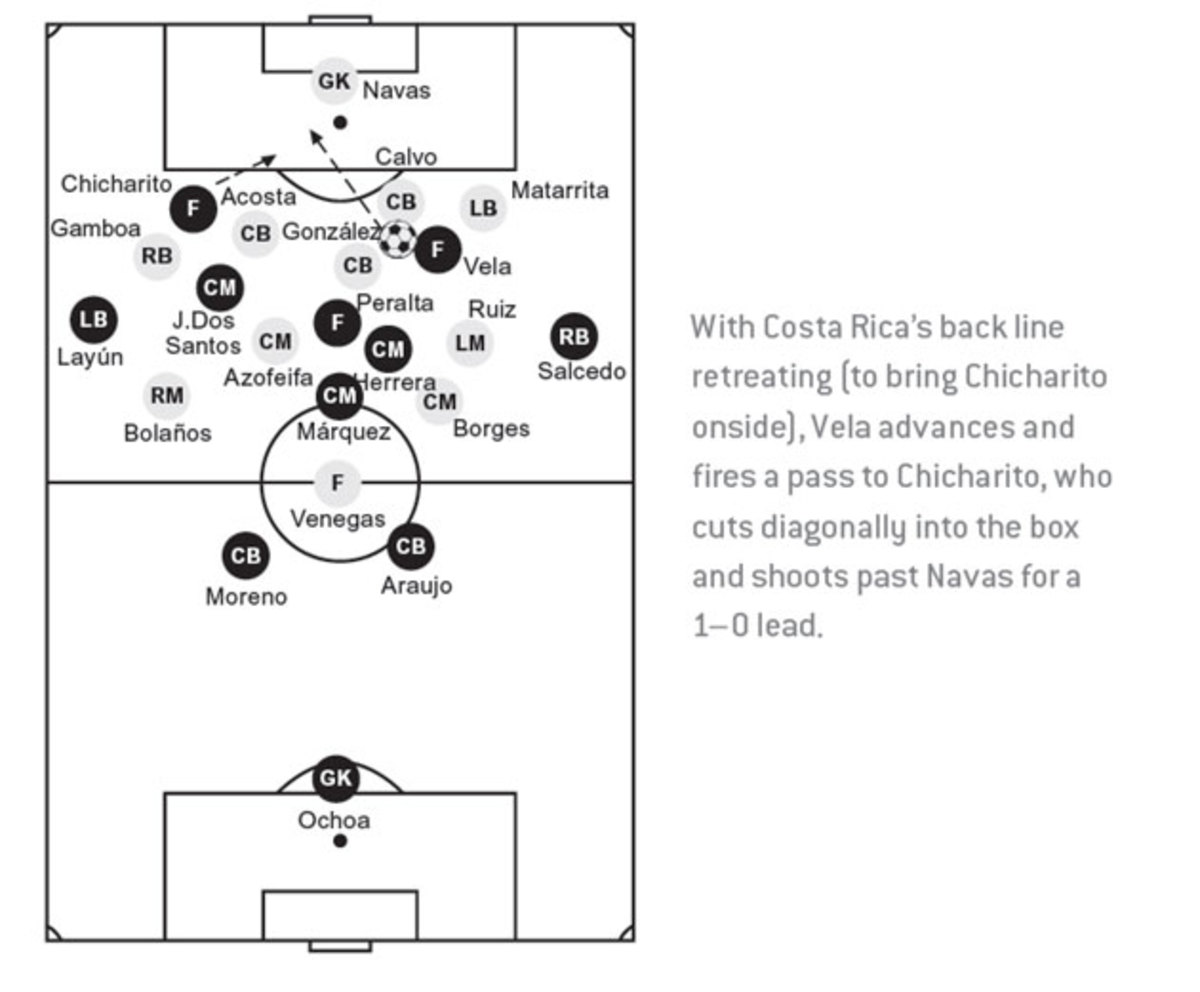
Design matters. Craft matters. Patterns matter.
All told, the sequence from Moreno’s pass deep in Mexico’s own end to Chicharito’s goal has involved five players, four passes, and just 11 seconds of elapsed time. Viewed at full speed, it’s a brilliant execution of synchronization.
